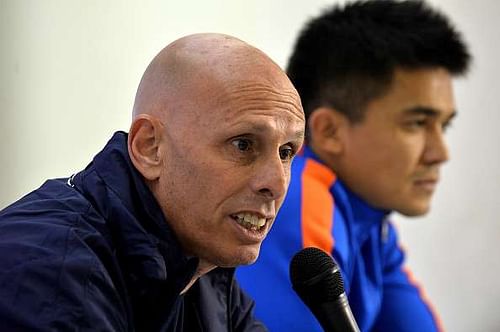
Clubs withholding players from Indian National Team: A good or bad thing?
The club vs country debate is something that has divided opinions in the Indian footballing fraternity recently. With the emergence of the Indian Super League (ISL) and its associated franchises who have shown a lack of willingness to release players for national duty including coaching and conditioning camps, the I-League clubs have also started adopting a tough stance on this matter. As a result, Indian coach Stephen Constantine has had a hard time in getting the players he wants for the national team and working with them.
Why the hard stance?
The level of competitiveness has gone up manifold in the I-League as well as the ISL with clubs seeking a return on their investments which naturally prevents them from releasing players for the long conditioning camps planned by Stephen Constantine. The clubs cite FIFA rules which state that a club has to release its players for only 4 days if he is called to play in a qualification match for a major tournament. If it is a minor tournament, the release period is only 2 days. The All India Football Federation (AIFF) also has its hands tied down in this regard with I-League CEO Sunando Dhar admitting that it could only request the clubs and not force them to release players.
Recently, 2015 I-League champions Mohun Bagan openly stated, “We will follow the FIFA rules and release our players accordingly whenever there is a call for national duty” – a sentiment echoed by their archrivals East Bengal. In fact, current I-League champions Bengaluru FC refused to allow India captain Sunil Chhetri and another 9 of their players from participating in a preparatory camp before the SAFF Championship in Trivandrum in December 2015 which greatly hampered Constantine.
Club vs Country in India, historically
The precedent of not releasing players for national duty became prevalent in India during the 1970s when then CM of West Bengal, Siddharth Shanker Ray, used football to stop youths from joining Naxal movements. In fact, Ray wrote to PM Indira Gandhi to exclude Kolkata players from national duty so that they can play the Kolkata league, especially for East Bengal, which historically commanded a fanatical following from those who were displaced from Bangladesh after the partition.
This precedent led to controversy just before the 1982 Asian Games, when 21 players (19 of them from Bengal) walked out of the national camp just ahead of the transfer season in Bengal, in order to play for their clubs which gave them lucrative offers. This forced the AIFF to start compensating players monetarily for national duty.
The crisis escalated in 2011 at the zenith of the Goa-Kolkata footballing rivalry when Dempo ordered their players to return from national camps alleging that the AIFF had compromised with the Kolkata clubs and selected only a few of their players.
Effect on Indian football
FIFA rules on clubs releasing players work well for European or South American nations which are footballing superpowers, whose players receive professional training and exposure at the highest level of football and hence can easily adapt to the ways of their national coach in 3-4 days.
But India, who languish at the wrong end of the world rankings, requires a concerted effort from all stakeholders including clubs, officials, players and support staff to bring the level of players up. The national coach needs to be given support to mould and shape the squad and provide quality exposure to high-level football by frequently playing good opponents.
In fact, one of the star coaches in India – Armando Colaco (the first I-League manager to guide his club to the semifinals of the AFC Cup with Dempo in 2008) – summed how the ‘club vs country debate’ is hampering India perfectly earlier this year when he said, “Constantine is building a team, a youthful team. If he works hard with the team, we can expect results after three or four years. Football is all about understanding and working together as a unit. [But] clubs don’t release players for national duty. ”
The way forward?
When clubs fail to allow their players to train under the national coach, it inadvertently leads to a situation where the coach is not able to improve the team according to his philosophy and unless the players receive top class exposure at club level, this precedent is bound to be harmful in the long run.
The AIFF, who prepared the national team haphazardly previously, is now ready to spend what is necessary to get proper International exposure which in turn is causing much grief to the clubs who loathe releasing their players mid-season. A compromise is of high priority between the national body and the clubs with this regard for Indian football to move forward.
Also read: Stephen Constantine feels Indian Football would benefit if clubs had an access to Sports Science
A result of both Constantine’s policy of promoting youth and the unavailability of regular players at all times is the fact that more than 25 players have made their debut for India in a period of last 18 months. This sort of experimentation is not what India needs right now, summed up by a humiliating loss against Guam (a tiny Pacific ocean island) in the World Cup qualifiers last year.
Constantine has made it clear many times that several Indian players can play in lower European leagues like Gurpreet Singh Sandhu, who plies his trade with Norwegian outfit Stabaek FC. But there needs to be fine balance between the needs of clubs in the Indian leagues (ISL and I-League which might merge next year) and the bigger picture of progress in terms of the national team.
